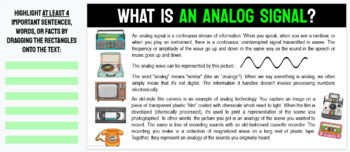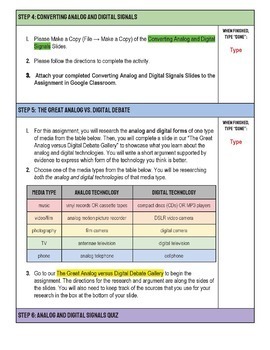Analog and Digital Signals Lesson | Waves Activities
- PDF
- Google Apps™

What educators are saying
Also included in
- This is a bundle of all of my resources for teaching physical science at the middle school level! These resources include a mix of Cornell Doodle Notes, labs, demonstrations, inquiry activities, self-paced digital 5E lessons, manipulatives, projects, pixel art review activities, and assessments. IPrice $297.00Original Price $384.06Save $87.06
- This is a bundle of all of my resources for teaching physical science at the 8th grade level WITHOUT the Cornell Doodle Notes included. I put together this bundle upon request from customers who had already purchased my Growing Bundle of Physical Science Cornell Doodle Notes or my Entire Store BundPrice $187.00Original Price $246.28Save $59.28
- Looking for fun, engaging, no-prep ways to teach your physical science students about WAVES? This unit covers sound and light waves, the electromagnetic spectrum, and information transfer using analog and digital signals. This bundle contains SO much content for teaching about the nature and behavioPrice $36.00Original Price $45.27Save $9.27
Description
In this week-long self-paced lesson, students will learn about the characteristics and uses of analog and digital signals. Students will be able to identify analog and digital technologies, explain how waves can be used for communication, and simulate how analog waves can be converted to digital signals and back again. Students will be able to construct an argument supported by evidence for whether the analog or digital version of a type of information transfer is better.
Students will work through 6 self-paced steps on a Google Doc. They will also work on supporting documents that are linked to the main Google Doc. As students finish the work for each Step, they type "Done" in the right-hand column of their table. This assignment can be completely facilitated using Google Classroom. It's easy to modify for differentiation and it's easy to grade! You could use this lesson for independent self-paced coursework for classes with 1:1 devices, for sub plans, for distance-learning, or even for science centers.
This lesson incorporates different learning modes and activities. The variety of activities that make up this lesson include:
- asking questions about a real-life example of analog and digital information transfer
- defining the concepts analog and digital using simple examples
- an EdPuzzle video comparing the advantages and disadvantages of analog and digital signals
- a Google Slides activity explaining how analog and digital signals transmit information
- a graphing activity simulating how an analog sound wave is sampled and converted into a digital signal for storage and transmission and then reconstructed into an analog wave for listening
- a mini-research assignment called “The Great Analog vs. Digital Debate” which includes a class gallery so students can share their work with one another
- a Google Form quiz on analog and digital signals
This download includes links to make copies of all parts of this lesson into your Google Drive. Answer keys are included. Detailed teacher notes explain how to facilitate this lesson using Google Classroom, how to edit and modify any of the documents, and how to efficiently grade this assignment.
My students have responded so well to this distance learning lesson format because they like that they can work at their own pace. I love that I can set a due date and then pop into their document when I want to get a sense of their progress. Students will attach supporting documents to the assignment in Google Classroom, which makes grading super easy and accessible.
For a distance learning scenario, I suggest for students to complete one or two Steps per day, so I give them about 5 or 6 days to complete this entire lesson. In the meantime, I check in on everyone's progress a couple of times to make comments, answer questions, and interact with the students. This lesson is perfect for classrooms with 1:1 devices and could also be used in class. I would allow 3 to 4 50-minute class periods for this lesson.
This lesson was written to satisfy NGSS MS-PS4-3: Waves and their Applications in Technologies for Information Transfer (Integrate qualitative scientific and technical information to support the claim that digitized signals are a more reliable way to encode and transmit information than analog signals.)
Please view the Preview to get a better idea of what is included!
You may also be interested in these resources:
Mechanical Waves Cornell Doodle Notes
Sound Waves Self-Paced Digital Lesson
Light Waves Self-Paced Digital Lesson
Thanks for looking!
Sunrise Science








